Choosing the Ideal Bedding for Bird Cages


Intro
When it comes to keeping pet birds, the selection of bedding may not be the most glamorous topic, but it’s certainly central to your feathered friends' health and wellbeing. The bedding in a bird cage doesn’t merely serve as a cushion for your pet’s feet. It plays a significant role in maintaining hygiene, providing comfort, and even preventing potential accidents. This guide will dissect the various materials available, focusing on their strengths and weaknesses while considering the diverse needs of different species of birds.
Bedding choices can affect everything from your bird's respiratory health to their general behavior. Understanding these elements ensures you create a cozy space for your companion that meets their needs. As we explore this topic, we will also touch on some common mistakes to avoid and how to maintain a clean living environment suitable for birds. With this knowledge, you’ll be armed to make the best decisions for your feathery pals.
Care Tips
Taking care of your bird and providing the right bedding is essential. Here are some practical tips that may help you in this endeavor.
Daily Care Routines
Each day begins with assessing the condition of your bird’s cage and bedding. Create a routine where you check for any droppings, uneaten food, or signs of mold or mildew. Clean up any mess promptly as this can prevent the onset of health issues. A fresh layer of bedding can also uplift your bird’s mood, making their space feel new and inviting.
Cage Setup and Maintenance
Setting up the cage with the right bedding is the first step toward creating a healthy environment. Here are some common bedding options:
- Paper-based products: These are often the easiest to clean and replace, making them a popular choice.
- Aspen shavings: A natural, absorbent alternative that’s free of aromatic oils, making it safer for birds.
- Coconut fiber: Excellent for nesting, but should be used with caution to avoid ingestion.
Ensure that the bedding is spread evenly across the cage bottom, allowing for easy cleanup while maximizing comfort.
Hygiene and Cleaning Practices
Keeping the cage clean goes beyond just changing the bedding. It’s recommended to fully clean the cage once a week, ensuring all surfaces are disinfected. Use bird-safe cleaning products— staying away from strong chemicals— is how you can keep your feathery friend safe. Change the bedding weekly or bi-weekly based on the activity and number of birds.
Seasonal Care Adjustments
As the seasons change, so may your bird's needs. In colder months, consider adding a thicker layer of bedding for insulation. In summer, moisture control becomes more crucial, so opt for materials that allow airflow while staying absorbent. Adjusting your care routine as the seasons change can lead to a happier and healthier bird.
Tip: Always monitor your bird's reactions to changes in bedding. Their body language can tell you if they are comfortable or uneasy.
Behavioral Insights
Birds are creatures of habit and understanding their behaviors can greatly enhance their living environment. By being observant, you can encourage positive behavior while deterring negative tendencies.
Understanding the Importance of Bedding
Bedding plays a crucial role in the overall wellbeing of pet birds. It serves multiple functions that directly impact their health and comfort. When we choose the right bedding, we are not merely picking a bottom layer for the bird cage; we are setting up an environment which can greatly influence their quality of life. Different types of bedding materials serve unique purposes, and understanding these can help bird owners make wiser choices.
Role in Bird Health
Bird health is paramount for any bird owner. One of the most significant roles of bedding is absorbency. Bird droppings can lead to damp and unsanitary conditions if not effectively absorbed. Appropriate bedding helps to soak up moisture and control odor, reducing the risk of bacterial growth that can lead to diseases. Additionally, certain materials can provide a cushiony surface for birds to stand or sit on, promoting spinal health and overall comfort.
When birds are in a clean and healthy environment, they are less likely to succumb to respiratory issues or skin irritations. It's worth mentioning that some birds might ingest bedding material, which means that safety is also a vital consideration. Always ensure that the materials are free from toxins, which can pose serious health risks.
Impact on Behavior
The type of bedding can significantly influence a bird’s behavior. A suitable environment encourages natural behaviors such as foraging, nesting, and playing. For example, paper-based bedding often allows birds to shred and rearrange, which can be a form of enrichment. Birds are wired to interact with their surroundings, and bedding that is engaging can prevent boredom, leading to healthier and happier pets.
Conversely, when bedding is too hard or uncomfortable, it can lead to stress and irritability. Birds might become aggressive or withdrawn in environments that don’t feel safe or comfortable. Understanding how different materials can affect bird behavior is essential, particularly for owners who want a harmonious and stimulating environment.
Bedding and Stress Reduction
Stress in birds is a serious concern; it can lead to a range of health problems and behavioral issues. Good bedding can help create a calming atmosphere. Soft and absorbent materials can make a bird feel secure in its space. Furthermore, bedding that mimics natural environments can significantly reduce stress levels. For example, coconut fiber gives a more natural touch and can even encourage instincts like burrowing or nesting.
Not only does appropriate bedding cushion the impact of perching and landing, but it can also absorb sounds that might otherwise startle the birds. A quieter cage results in a less stressful experience for the birds, making them feel more at home in their surroundings.
"Using the right bedding materials isn’t just about comfort; it’s about creating a nurturing environment that caters to the needs of your feathered friends."
Selecting the correct bedding is a thoughtful process that involves understanding its importance and its multifaceted benefits. When bird owners take the time to consider what goes into their bird’s space, it results in healthier, happier birds.
Types of Bedding Materials
Choosing the right bedding material for bird cages is crucial, not just for aesthetic reasons, but primarily for the health and comfort of your birds. Different types of bedding materials serve various purposes and come with their own sets of advantages and disadvantages. When selecting bedding, consider factors such as absorbency, safety, and impact on the environment. This section will dive into the various types of bedding materials commonly used for pet birds, helping you make an informed choice that supports your feathered friends’ needs.
Paper-Based Options
Paper-based bedding options are a popular choice among bird owners due to their ease of use and disposal. They are often made from recycled materials, contributing to environmental sustainability while providing a comfortable, safe space for birds.

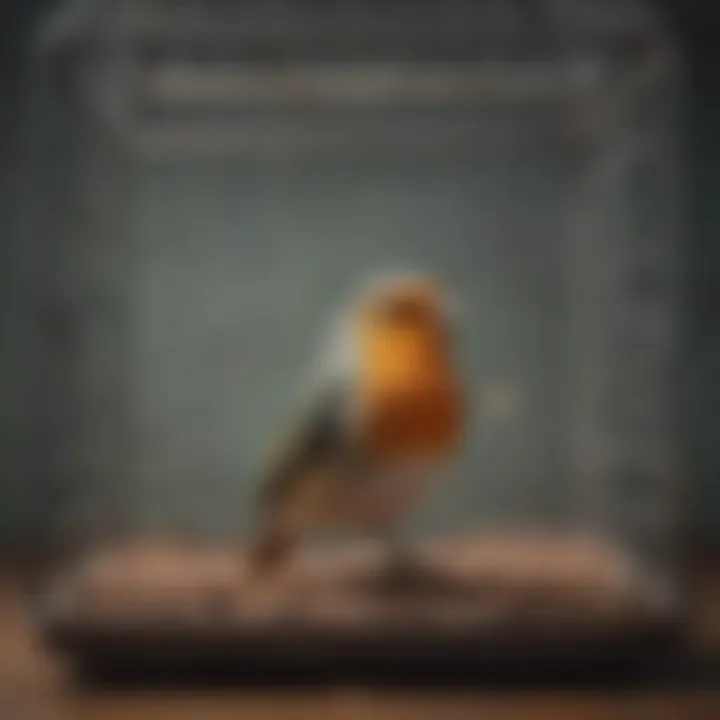
Recycled Paper Bedding
Recycled paper bedding stands out for its commitment to eco-friendliness. Made from repurposed paper products, this bedding is not only biodegradable but also highly absorbent, which helps to control odors effectively. Since it’s soft to touch, your birds can comfortably burrow into it, mimicking natural nesting behavior. However, owners should ensure they’re sourcing bedding that is free from toxic dyes or chemicals, which can harm birds over time.
Newsprint
Newsprint is often used as a cost-effective option for bird bedding. Its main charm lies in its affordability and prevalence. However, it does require frequent changes to maintain hygiene, as it can become soiled quickly. The primary downside is the ink sometimes used on these papers, which may contain harmful substances. If you opt for newsprint, choosing unscented, non-toxic ink varieties is essential to keep birds safe.
Paper Towels
Paper towels are a staple for many bird owners due to their convenience and ease of maintenance. They absorb moisture well, can be disposed of easily, and provide a clean environment. This makes them particularly useful for new bird owners or in situations where quick and simple cleanup is necessary. However, the downside is that they must be changed frequently to prevent unsanitary conditions, and they can sometimes be less comfortable for birds compared to other bedding types.
Wood-Based Choices
Wood-based bedding materials offer natural insulation and can also absorb moisture effectively. However, bird owners need to tread carefully, as not all wood types are safe for all species.
Pine Shavings
Pine shavings are among the most common bedding materials. They are favored for their excellent absorbency and pleasant scent. However, pine should be kiln-dried to eliminate harmful oils that can irritate a bird’s respiratory system. Some birds might also find the texture comforting for nesting, but others may develop allergies, making it crucial for owners to monitor their birds closely.
Aspen Shavings
Aspen shavings present an alternative that many bird owners prefer. They are typically free from toxic oils and provide a soft, comfortable surface for birds. Their ability to control moisture and reduce odors is commendable. As a bonus, aspen shavings break down more easily than pine in the environment, thus being more eco-conscious. Their main drawback is that they may not retain moisture as effectively as other options, necessitating frequent changes.
Cedar Shavings
Cedar shavings are often pushed aside for bird bedding because they can release aromatic oils that might irritate a bird's lungs. Though they possess natural antibacterial properties and have a pleasant scent, the risks generally outweigh the benefits. Bird owners need to be cautious since exposure to cedar aroma can lead to respiratory issues in sensitive species. It’s best to consult with avian specialists before using cedar as a primary bedding material.
Natural Fiber Products
Natural fiber products are gaining traction among bird enthusiasts, often heralded for their sustainability and ability to mimic natural habitats.
Coconut Fiber
Coconut fiber, or coir, provides a rustic look and is biodegradable. It excels in moisture absorption while being resistant to mold and mildew. The soft texture makes it advantageous for birds who enjoy digging. However, it can sometimes hold its scent and may need more frequent changes to maintain freshness in the cage.
Hemp Bedding
Hemp bedding is another strong contender for eco-friendliness, as it is rapidly renewable and highly absorbent. Hemp’s fibrous nature provides excellent moisture-wicking properties and is gentle on birds’ feet. Despite its many benefits, some users might find hemp less readily available or more expensive than traditional bedding options.
Synthetic Materials
Synthetic bedding might not be many folks' first choice due to environmental concerns. However, it can sometimes offer unique benefits.
Plastic Mats
Plastic mats are designed for ease of cleaning and durability. Owners can simply wipe them down and reuse them, making them cost-effective in the long run. Their main downside is that they may not provide the softness or comfort that birds prefer. Additionally, if not monitored, they can lead to slippery surfaces that could contribute to accidents.
Synthetic Grass
Synthetic grass offers birds a unique texture that can be beneficial for their claws and overall mental stimulation. While visually appealing, it requires thorough cleaning to prevent bacteria buildup and can be more challenging to maintain compared to natural options. Regular checks are essential to ensure no surface wear occurs, which could impede the health of the birds.
Each bedding type carries its pros and cons, making the decision primarily dependent on individual bird needs and owner preferences. By carefully considering these options, bird owners can create a comfortable and safe habitat that aligns with the natural tendencies of their feathered companions.
Eco-Friendly Bedding Solutions
As more pet bird owners become aware of their environmental footprint, eco-friendly bedding solutions have gained significant traction. This is not just a trend but a necessity. Choosing materials that are both safe for birds and sustainable for the planet is essential. Eco-friendly bedding can significantly reduce landfill waste, lower resource consumption, and ensure that your feathered companions thrive in a clean, natural environment. These solutions encompass biodegradable options and sustainable sourcing, both crucial for promoting a healthier ecosystem.
Biodegradable Options
When discussing bedding materials for bird cages, biodegradable options come to the forefront. Unlike traditional bedding that might linger in landfills for centuries, biodegradable materials are crafted from natural substances that decompose over time. This not only benefits the environment but also boosts the quality of life for birds.
Benefits of Biodegradable Bedding:
- Natural Decomposition: Products like recycled paper bedding and coconut fiber degrade naturally, providing a guilt-free disposal method.
- Reduced Chemicals: Biodegradable options often contain fewer synthetic chemicals, lowering the risk of harmful exposure for birds.
- Enhanced Comfort: These materials can mimic natural conditions, offering birds a more familiar and comfortable living space.
Some excellent examples include:
- Coconut Fiber: This option is derived from the husk of coconuts and is known for its excellent absorbency, reducing odors effectively.
- Recycled Paper Bedding: Made from processed newspaper or cardboard, it's an economical and environmentally friendly choice. Plus, it’s softer than some other materials, making it comfortable for small birds.
Sustainable Sourcing
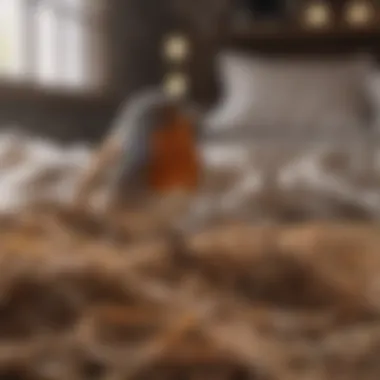
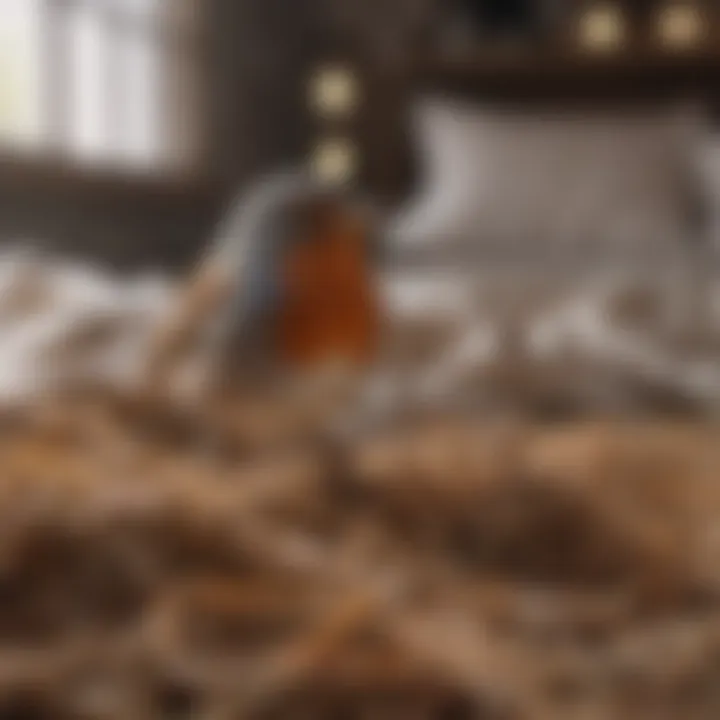
Sustainable sourcing is another pillar of eco-friendly bedding solutions. It refers to choosing materials that are produced in a way that conserves resources and minimizes harm to the environment. This is particularly important for materials derived from trees, as overharvesting can lead to habitat destruction.
Considerations for Sustainable Sourcing:
- Certifications: Look for products that carry certifications, such as the Forest Stewardship Council (FSC) label, which indicates that the wood or fiber has been sourced sustainably.
- Local Sources: Purchasing from local manufacturers can reduce transportation emissions, further enhancing the sustainability factor.
Options for sustainably sourced bedding materials include:
- Cedar Shavings: When sourced from managed forests, cedar can offer a pleasant scent and natural insect repellent qualities, though it should be noted that some birds may be sensitive to the oils in cedar.
- Hemp Bedding: Made from hemp stalks, this option is not only biodegradable but also requires few pesticides and herbicides during its cultivation, making it an environmentally friendly choice.
"Choosing eco-friendly bedding options isn’t just about the birds; it's about ensuring a healthier planet for future generations of both birds and their owners."
Factors to Consider When Choosing Bedding
Selecting the right bedding for bird cages is not merely about aesthetics or convenience. It's a critical element that affects the well-being of our feathered companions. Factors such as absorbency, safety, and comfort deserve thorough consideration. These aspects not only enhance the quality of life for birds but also contribute to their overall health and happiness.
Absorbency and Odor Control
Birds can be messy creatures. High absorbency in bedding materials is essential to managing droppings and spilled food. Good bedding absorbs moisture effectively, preventing the growth of harmful bacteria that can lead to health problems. For instance, paper-based products like recycled bedding are often touted for their absorbent properties. What’s more, they also help in controlling odors, as they trap unwanted smells more proficiently than other materials.
Consider the following when evaluating absorbency and odor control:
- Material Composition: Certain materials naturally handle moisture better. For example, coconut fiber might be less absorbent than paper but provides other benefits that may be preferable.
- Frequency of Change: The more absorbent a bedding is, the less frequently it may need to be changed, saving you time and effort.
Safety Concerns
Ensuring the safety of your birds cannot be overstated. Some bedding materials may contain harmful substances, such as toxic chemicals or sharp particles that can cause injuries. Cedar shavings, despite being popular, can emit phenols that are detrimental to a bird's respiratory health. Likewise, any bedding that produces dust particles can lead to breathing issues, particularly in sensitive species.
Here are a few safety considerations when selecting bedding:
- Chemical Treatment: Always check if the bedding has been treated with pesticides or other chemicals—these can be harmful.
- Physical Texture: Avoid materials that could splinter or have sharp edges. Opt for softer materials that pose less risk of injury.
Comfort for the Birds
Comfort is paramount. Bedding should not only be functional but also provide a cozy environment for your birds. Birds spend a significant amount of time perched and resting, so the substrate underfoot can impact their overall well-being. Materials like hemp bedding and aspen shavings are often recommended for their gentle touch, offering a soft landing for small feet.
When contemplating comfort:
- Thickness: The thickness of the bedding can vary, and too thick a layer might hinder movement, while too thin might not provide sufficient cushioning.
- Texture: Birds tend to prefer materials that mimic natural environments. Soft, natural fibers often help replicate their wild counterparts' habitats, making them feel secure and relaxed.
"When choosing bedding, think beyond just the aesthetic; your birds’ health truly depends on it."
In summary, when selecting bedding for your feathered friends, account for absorbency, safety, and comfort. These elements work together to provide a nurturing habitat that allows birds to thrive. With careful consideration, you can create a space that promotes their health and happiness, giving you greater peace of mind as a bird owner.
Maintaining Cleanliness in Bird Cages
Keeping a bird cage clean is not merely about aesthetics; it's crucial for the health and well-being of our feathered companions. A clean environment reduces the risk of diseases, minimizes stress, and contributes to a happier, healthier bird. Failing to maintain cleanliness can lead to problems such as odors, insect infestations, and even respiratory issues. Therefore, understanding how to keep a bird cage tidy is essential for both experienced aviary owners and new bird parents alike.
Routine Cleaning Schedule
Establishing a routine cleaning schedule is fundamental in maintaining a hygienic space for your birds. Regular cleaning prevents the buildup of waste and food remnants that can attract pests or harbor disease. Here are some guidelines to consider:
- Daily Spot Cleaning: Take a few minutes every day to remove any droppings or uneaten food from the cage. This not only keeps their living area fresh but also allows you to observe your bird's health by noting changes in droppings or activity.
- Weekly Deep Clean: Aim for a thorough cleaning once a week. This means removing all bedding material, disinfecting perches, toys, and any other accessories. Rinse and dry thoroughly before replacing items in the cage. An effective mixture for disinfecting can be created using vinegar and water, which is safe for birds.
- Seasonal Overhaul: Every few months, conduct a deep clean beyond what you may do weekly. This might involve washing down the entire cage with soap, checking for wear on toys and perches, and replacing any items that show signs of damage or soiling.
Keeping the cleaning routine consistent acts like a double-edged sword—ensuring the birds stay healthy and providing peace of mind to the owners.
Choosing the Right Cleaning Products
When it comes to cleaning, not every product on the market is suitable for feathered friends. The right cleaning products will ensure that the cage remains a safe haven for your birds. Consider these factors:
- Safe Ingredients: Choose products labeled as non-toxic for birds. Many common household cleaners contain harmful chemicals that can irritate a bird's respiratory system or, worse, be fatal if ingested.
- Natural Solutions: Vinegar, baking soda, and lemon juice can act as effective cleaning agents without the dangers posed by synthetic cleaners. For example, a paste of baking soda mixed with water can take on stubborn stains while keeping the area safe for your pets.
- Avoiding Fragrance: Select unscented products as many fragrances can be overwhelming to birds. Even seemingly harmless scents can induce stress or respiratory issues.
A bird's respiratory system is sensitive; always err on the side of caution by reading labels and ensuring your cleaning supplies are safe.
Common Mistakes in Bedding Selection
Selecting the right bedding for bird cages isn't just a matter of preference; it's a vital aspect of bird care. Even the most experienced bird owners can sometimes trip up and make mistakes when choosing bedding, leading to health and comfort issues for their feathered friends. Understanding these common missteps can significantly enhance the quality of life for your birds.
Overlooking Material Safety
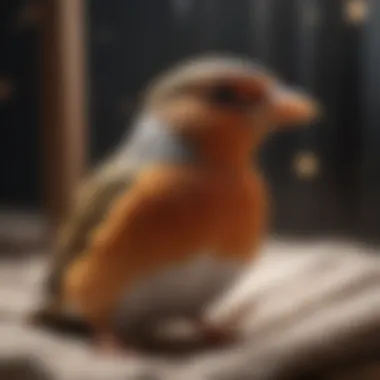
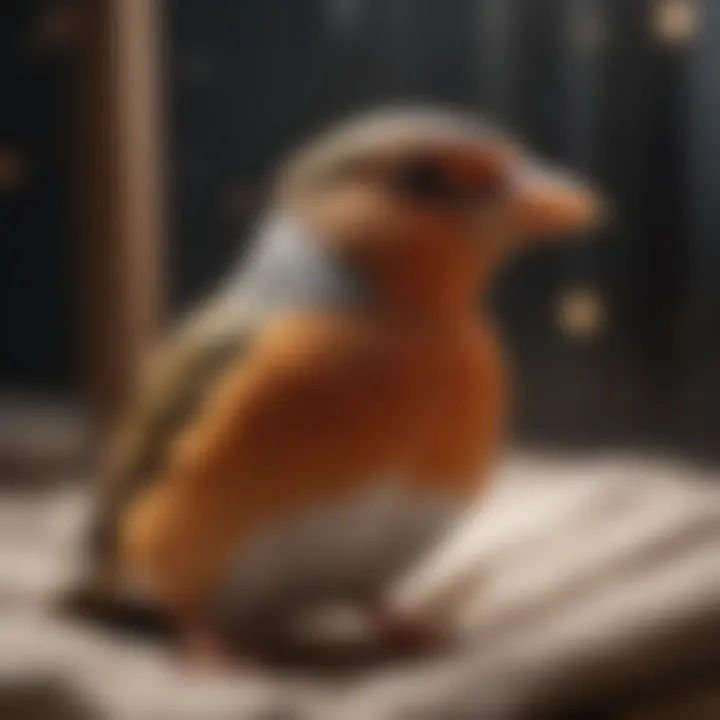
One of the most significant blunders is not paying close attention to the materials used in bedding. Safety should always be at the forefront of your considerations. Birds are incredibly sensitive creatures. Their respiratory systems can react negatively to bedding that contains harmful chemicals or dust. For instance, cedar shavings may smell delightful to us but they often release harmful phenols that can lead to respiratory problems. Always opt for bedding labeled as non-toxic and specially designed for avian use. Checking for certifications or guidelines from reputable sources can save you a world of headaches down the line.
Even something seemingly harmless, like paper products, might be coated with ink or chemicals that pose risks. Always read labels and research the source of your bedding material to ensure it’s bird-safe.
Choosing Inappropriate Thickness
Another pitfall is selecting the wrong thickness of bedding. This aspect may seem trivial but can greatly influence your bird's comfort. If the bedding is too thick, your birds might struggle to navigate their cage, potentially leading to injuries. On the other hand, bedding that’s too thin can fail to absorb droppings effectively, making for an unpleasant living environment.
For smaller birds like finches, thinner layers of bedding suffice since they don't create a lot of waste. Larger birds, like parrots, often require thicker bedding due to their higher waste output and tendency to dig. Finding the right balance can make all the difference in maintaining cleanliness and comfort within the cage.
Bedding for Specific Bird Species
Choosing the right bedding for your birds is not a one-size-fits-all endeavor. Different bird species have their own unique needs and characteristics that influence their comfort, safety, and overall health. Understanding these nuances can help bird owners select bedding that not only meets the general standards of cleanliness and safety but also caters to the specific preferences of their feathered companions. The right bedding can promote better health, enhance behavioral enrichment, and contribute positively to the wellbeing of the birds.
Small Birds
When it comes to small birds, such as canaries or finches, the right bedding can make a world of difference. These birds typically require a bedding that provides adequate absorbency while being soft enough to ensure comfort during rest. Paper-based bedding options like recycled paper or newsprint are particularly favorable for small birds. They tend to be light, easy to change, and dust-free, reducing the risk of respiratory issues.
Also, remember that small birds can be sensitive to strong smells or irritants, so a bedding that keeps odors at bay is crucial. It’s worthwhile to check labels for any chemicals or fragrances, just in case. Additionally, choose a bedding that allows for easy monitoring of droppings, helping you quickly spot any health issues.
Medium-Sized Birds
Medium-sized birds like cockatiels and lovebirds have their own particular requirements. They may benefit from more robust options, as their activity levels can be higher. Wood-based bedding, such as aspen shavings, offers a great compromise, providing durability while also being soft on their little feet. However, cedar shavings should generally be avoided due to their strong aroma, which can be harmful.
One thing to keep in mind is the thickness of the bedding. Too thin, and it won't absorb waste effectively, leading to damp conditions; too thick, and it may pose a risk of accidental injury or create nests that attract unwanted behavior. Monitoring the condition of the bedding regularly is key to maintaining a healthy habitat for these lively birds.
Large Birds
Bedding choices require more thought for large birds, such as parrots and macaws. Given their size and strength, bulkier bedding options can offer safer protective measures. Coconut fiber is an excellent choice here, as it is not only absorbent but also provides some level of comfort during rest periods. Manufacturers may sell this type of bedding in larger quantities, which can appeal to owners who want to maintain an ample supply.
Plastic mats are also popular among owners of large birds because they are easy to clean and help in managing messes. However, introducing a low layer of softer bedding, like paper or shredded cloth, can help mitigate any discomfort from the hard surface, especially when the bird chooses to rest.
The right bedding for large birds can also play a significant role in their psychological health. Large birds are known to be intelligent and social; they often need an environment that feels comfortable and secure. Thus, ensuring that the bedding supports their need to dig or shred becomes essential.
Remember, choosing the proper bedding is vital for the wellbeing of your birds—just as important as food and water.
In essence, it is crucial that bird owners carefully consider the specific requirements of the species they care for. Suitable bedding not only fosters a healthier environment but can also enrich the overall quality of life for your avian friends.
Cost Considerations
In the realm of bird care, the choice of bedding is not simply a matter of preference but also one that hinges significantly on costs involved. Averaging out the expense of appropriate bedding solutions can impact the overall budget of being a pet bird owner. It's all about finding a balance between quality and cost-effectiveness. Cheap options might seem appealing upfront, but they could lead to hidden costs down the line, including health issues for your birds or frequent replacements.
Evaluating Long-Term Value
When determining which bedding to invest in, consider the long-term value it brings. High-quality bedding might come with a steeper price but can yield savings in the future. This is often due to several factors:
- Durability: Premium materials usually last longer, requiring fewer changes, thus reducing the frequency of re-stocking.
- Absorbency: Better absorbent materials mean less waste and odor control, which keeps cages cleaner longer.
- Health Benefits: Investing in non-toxic, hypoallergenic options safeguards bird health, potentially saving on veterinary expenses.
Long-term value factors in not just the price tag of the bedding but the cost of care and health associated with the type you choose. If a bedding product helps you maintain a hygienic and stress-free environment for your birds, it might well be worth any extra dollars.
Bulk Purchase Options
For bird owners who have many feathered friends, buying bedding in bulk is an efficient way to cut costs. Many retailers offer significant discounts for bulk purchases, which can be just what the budget ordered. When considering bulk buys, keep these points in mind:
- Storage: Ensure you have an adequate space to store a larger quantity without it getting damaged.
- Shelf Life: Some beddings last longer than others. Paper products, for instance, can degrade over time, whereas certain wood shavings maintain their integrity longer.
- Comparative Shopping: It pays to do a little research. Some local pet shops or online retailers might have seasonal sales or loyalty programs that reward frequent buyers with better pricing.
Overall, making informed decisions about costs can lead to a more sustainable and enjoyable experience in caring for your birds. Paying attention to both initial costs and long-term value helps ensure that you’re getting the most bang for your buck, while also providing the best for your feathered companions.
"Quality over quantity often rings true, especially in pet care, where the right choices lead to happier, healthier birds."
By understanding the financial aspects associated with bedding, bird owners can better navigate their choices, ensuring they maintain a clean and inviting space for their beloved pets.
Finale and Recommendations
When it comes to providing the best for our feathered companions, the conclusion and recommendations section serves as a crucial compass for bird owners, guiding them through the myriad of bedding choices available in the market. Understanding what works best for different species of birds not only impacts their immediate comfort but also plays a pivotal role in their long-term health and behavior.
Preferred Choices for Different Birds
Choosing the right bedding material isn’t a one-size-fits-all scenario. Birds, like us, have varied preferences and needs based on their species.
- Small Birds: For finches and canaries, something like recycled paper bedding or newsprint tends to work well. These materials offer excellent absorbency while being soft enough for small feet. Avoiding thicker bedding helps prevent tiny birds from burrowing in too deep, which can create hazards.
- Medium-Sized Birds: For parakeets or cockatiels, a mixture of pine shavings and aspen shavings might be ideal. These provide a balance between comfort and the ability to control odor effectively. It's important to ensure the production is free from harmful materials.
- Large Birds: When it comes to larger species, such as macaws or cockatoos, using natural fiber products like coconut fiber is often preferred. These materials are durable, absorb well, and maintain a degree of comfort that these larger birds need. Avoid using cedar, as its oils can be harmful to birds.
Final Thoughts on Bedding Options
The right bedding can lead to a healthier, more engaged bird. It impacts how they feel day in and day out. Using materials that prioritize comfort, safety, and hygiene is paramount. While it’s tempting to go for whichever bedding is on sale, skimping on quality can be a grave error.
In weighing options, consider the environmental impact of materials. Eco-friendly choices not only benefit the planet but can also reassure pet owners knowing they are contributing to sustainability efforts. Avoiding toxic substances in bedding is equally essential; some birds are sensitive to certain chemicals, which can lead to health issues.
Ultimately, taking the time to carefully select your bird's bedding can foster a space that is safe, comfortable, and conducive to their overall well-being. Remember, a happy bird often leads to a happier pet owner. It's all about creating a home that mimics the coziness of their natural habitat but also provides the care that only we can.
A well-chosen bedding ensures peace of mind for both birds and their owners, fostering a harmonious environment.















